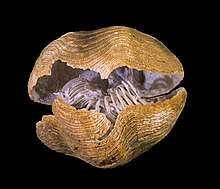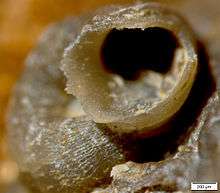Lophophore
The lophophore /ˈlɒfəfɔːr/ is a characteristic feeding organ possessed by four major groups of animals: the Brachiopoda, Bryozoa, Hyolitha, and Phoronida, which collectively constitute the protostome group Lophophorata.[1] All lophophores are found in aquatic organisms.


Etymology
Lophophore is derived from the Greek lophos (crest, tuft) and -phore, -phoros (φορος) (bearing), a derivative of phérein (φέρειν) (to bear); thus crest-bearing.
Characteristics
The lophophore can most easily be described as a ring of ciliated tentacles surrounding the mouth, but it is often horseshoe-shaped or coiled. Phoronids have their lophophores in plain view, but the valves of brachiopods must be opened wide to get a good view of their lophophore.
The lophophore surrounds the mouth and is an upstream collecting system for suspension feeding. Its tentacles are hollow with extensions of a coelomic space thought to be a mesocoel. The gut is U-shaped with the anterior mouth at the center of the lophophore. The anus, where present, is also anterior, but is dorsal to the mouth. In the Bryozoa it is outside the ring of the lophophore. Some brachiopods do not have an anus.
Classification of lophophorates
Groups with lophophores are called lophophorates. In the old view of metazoan phylogeny, the lophophorates were placed within the Deuterostomia. Now they have been reassessed and placed in a new superphylum known as the Lophotrochozoa[2] in the Protostomia, which includes the Mollusca and Annelida.
The extinct hederelloids, microconchids, cornulitids and tentaculitids were likely lophophorates based on their biomineralization.[3]
The position of the Hyolitha has long been disputed, but as of 2017 has been assigned to the Lophophorata, as finely-preserved specimens in the Burgess Shale can be seen to carry lophophores.[4] Lophophorates did appear paraphyletic but that is contested.[5][6][7]
References
- Introduction to the Lophotrochozoa - accessed 3 May 2010
- Giribet, G. (2008). "Assembling the lophotrochozoan (=spiralian) tree of life". Philosophical Transactions of the Royal Society of London. Series B, Biological Sciences. 363 (1496): 1513–1522. doi:10.1098/rstb.2007.2241. PMC 2614230. PMID 18192183.
- Taylor, P.D.; Vinn, O.; Wilson, M. (2010). "Evolution of biomineralization in 'lophophorates'". Special Papers in Palaeontology. 84: 317–333. Retrieved 11 June 2014.
- Moysiuk, Joseph; Smith, Martin R.; Caron, Jean-Bernard (2017). "Hyoliths are Palaeozoic lophophorates" (PDF). Nature. 541 (7637): 394–397. doi:10.1038/nature20804. PMID 28077871.
- Passamaneck, Y.; Halanych, K.M. (July 2006). "Lophotrochozoan phylogeny assessed with LSU and SSU data: evidence of lophophorate polyphyly". Mol Phylogenet Evol. 40 (1): 20–28. CiteSeerX 10.1.1.136.6365. doi:10.1016/j.ympev.2006.02.001. PMID 16556507.
- Struck, Torsten H.; Wey-Fabrizius, Alexandra R.; Golombek, Anja; Hering, Lars; Weigert, Anne; Bleidorn, Christoph; Klebow, Sabrina; Iakovenko, Nataliia; Hausdorf, Bernhard (1 July 2014). "Platyzoan Paraphyly Based on Phylogenomic Data Supports a Noncoelomate Ancestry of Spiralia". Molecular Biology and Evolution. 31 (7): 1833–1849. doi:10.1093/molbev/msu143. ISSN 0737-4038. PMID 24748651.
- Nesnidal, Maximilian P.; Helmkampf, Martin; Meyer, Achim; Witek, Alexander; Bruchhaus, Iris; Ebersberger, Ingo; Hankeln, Thomas; Lieb, Bernhard; Struck, Torsten H. (17 November 2013). "New phylogenomic data support the monophyly of Lophophorata and an Ectoproct-Phoronid clade and indicate that Polyzoa and Kryptrochozoa are caused by systematic bias". BMC Evolutionary Biology. 13: 253. doi:10.1186/1471-2148-13-253. ISSN 1471-2148. PMC 4225663. PMID 24238092.